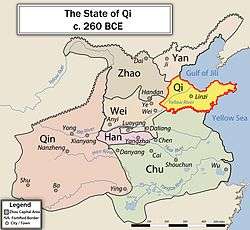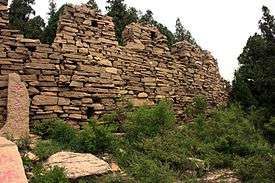Qi (state)
Qi was a state of the Zhou dynasty-era in ancient China, variously reckoned as a march, duchy, and independent kingdom. Its capital was Yingqiu, located within present-day Linzi in Shandong.
Qi | |||||||||
|---|---|---|---|---|---|---|---|---|---|
| 1046 BC–221 BC | |||||||||
 Qi in 260 BC | |||||||||
| Status | Duchy (1046–323 BC) Kingdom (323–221 BC) | ||||||||
| Capital | Yingqiu (Zibo) Bogu (Binzhou) | ||||||||
| Religion | Chinese folk religion ancestor worship | ||||||||
| Government | Monarchy | ||||||||
| King of Qi | |||||||||
| Chancellor | |||||||||
• 685–645 BC | Guan Zhong | ||||||||
| History | |||||||||
• Enfeoffment of Duke Tai | 1046 BC | ||||||||
• Conquered by Qin | 221 BC | ||||||||
| Currency | Knife money | ||||||||
| |||||||||
| Qi | |||||||||||||||||||||||||||||||||||||||
|---|---|---|---|---|---|---|---|---|---|---|---|---|---|---|---|---|---|---|---|---|---|---|---|---|---|---|---|---|---|---|---|---|---|---|---|---|---|---|---|
.svg.png) "Qi" in seal script (top), Traditional (middle), and Simplified (bottom) Chinese characters | |||||||||||||||||||||||||||||||||||||||
| Traditional Chinese | 齊 | ||||||||||||||||||||||||||||||||||||||
| Simplified Chinese | 齐 | ||||||||||||||||||||||||||||||||||||||
| |||||||||||||||||||||||||||||||||||||||

Qi was founded shortly after the Zhou overthrow of Shang in the 11th century BC. Its first marquis was Jiang Ziya, minister of King Wen and a legendary figure in Chinese culture. His family ruled Qi for several centuries before it was replaced by the Tian family in 386 BC.[1] In 221 BC, Qi was the final major state annexed by Qin during its unification of China.
History

Foundation
During the Zhou conquest of Shang, Jiang Ziya served as the chief minister to King Wu. After Wu's death, Jiang remained loyal to the Duke of Zhou during the Three Guards' failed rebellion against his regency. The Shang prince Wu Geng had joined the revolt along with the Dongyi states of Yan, Xu, and Pugu. These were suppressed by 1039 BC and Jiang was given the Pugu lands in what is now western Shandong as the march of Qi. Little information survives from this period, but the Bamboo Annals suggest that the native people of Pugu continued to revolt for about another decade before being destroyed a second time c. 1026.
In the mid-9th century BC, King Yi (r. 865–58 BC) attacked Qi and boiled Duke Ai to death. Under the reign of King Xuan (r. 827–782), there was a local succession struggle. During this time, many of the native Dongyi peoples were absorbed into the Qi state.
Spring and Autumn period

In 706 BC, Qi was attacked by the Shan Rong. Qi rose to prominence under Duke Huan of Qi (685–643 BC). He and his minister Guan Zhong strengthened the state by centralizing it. He annexed 35 neighboring states including Tan and brought others into submission. In 667 BC, Duke Huan met with the rulers of Lu, Song, Chen and Zheng and was elected leader. Subsequently, King Hui of Zhou made him the first Hegemon. He attacked Wei for supporting a rival of the Zhou king and intervened in the affairs of Lu. In 664 BC, he protected Yan from the Rong. In 659 BC, he protected Xing and in 660, Wei, from the Red Di. In 656 he blocked the northward expansion of Chu. After his death, a war of succession broke out among his sons, greatly weakening Qi. The hegemony consequently passed to Jin.
In 632 BC, Qi helped Jin defeat Chu at the Battle of Chengpu. In 589 BC, Qi was defeated by Jin. In 579 BC, the four great powers of Qin (west), Jin (center), Chu (south) and Qi (east) met to declare a truce and limit their military strength. In 546 BC, a similar four-power conference recognized several smaller states as satellites of Qi, Jin and Qin.
Warring States period
Early in the period, Qi annexed a number of smaller states. Qi was one of the first states to patronize scholars. In 532 BC, the Tian clan destroyed several rival families and came to dominate the state. In 485 BC, the Tian killed the ducal heir and fought several rival clans. In 481 BC, the Tian chief killed a puppet duke, most of the ruler's family, and a number of rival chiefs. He took control of most of the state and left the Duke with only the capital of Linzi and the area around Mount Tai. In 386 BC, the House of Tian fully replaced the House of Jiang as rulers of Qi. In 222 BC, Qi was the last of the warring states to be conquered by Qin, thereby putting an end to the wars and uniting China under the Qin Dynasty.
Culture of Qi
Before Qin unified China, each state had its own customs and culture. According to the Yu Gong or Tribute of Yu, composed in the 4th or 5th century BC and included in the Book of Documents, there were nine distinct cultural regions of China, which are described in detail in this book. The work focuses on the travels of the titular sage, Yu the Great, throughout each of the regions. Other texts, predominantly military, also discussed these cultural variations.
One of these texts was The Book of Master Wu, written in response to a query by Marquis Wu of Wei on how to cope with the other states. Wu Qi, the author of the work, declared that the government and nature of the people were reflective of the terrain of the environment in which they inhabited. Of Qi, he said:
Although Qi's troops are numerous, their organization is unstable... The people of Qi are by nature unyielding and their country prosperous, but the ruler and officials are arrogant and care nothing for the people. The state's policies are not uniform and not strictly enforced. Salaries and wages are unfair and unevenly distributed, causing disharmony and disunity. Qi's army is arrayed with their heaviest hitters at the front while the rest follow behind, so that even when their forces appear mighty, they are in reality fragile. To defeat them, we should divide our army into three columns and have two attack the left and right flanks of Qi's army. Once their battle formations are thrown into disarray, the central column should be in position to attack and victory will follow.
— Wuzi, Master Wu
While visiting Qi, Confucius was deeply impressed with perfection of performance of Shao music 韶 therein.[2]
During the Warring States period, Qi was famous for its capital's academy Jixia, renowned scholars of the era from all over China visited the academy.
Qi architecture

The state of Qi was known for having well organized cities that were nearly rectangular in shape, with roads that were neatly knit into a grid-like pattern. The palace was strategically positioned facing the south. To the left (eastwardly direction) of the palace resided the ancestral temple, to its right (westward) the temple of the gods, both one hundred paces away. This ensured that balance was achieved. In front of the palace was the court also one hundred paces away and to the back of the palace was the city. This type of layout influenced greatly the way cities were designed in subsequent generations.
Smaller cities known as chengyi (城邑) were abundant throughout Qi. They typically stretched 450 meters from south to north and 395 meters from east to west. The perimeter was usually surrounded by a wall with the living headquarters situated within and a nearly perfect square-shaped courtyard occupying the center.[3]
Qi in astronomy
Qi is represented by the star Chi Capricorni in the "Twelve States" asterism in the "Girl" lunar mansion in the "Black Turtle" symbol. Qi is also represented by the star 112 Herculis in the "Left Wall" asterism in the "Heavenly Market" enclosure.
Rulers
House of Jiang
| Title | Name | Reign (BC) | Relationship | Notes |
|---|---|---|---|---|
| Duke Tai 齊太公 | Lü Shang 呂尚 | 11th century | Enfeoffed by King Wu of Zhou, with capital at Yingqiu | |
| Duke Ding 齊丁公 | Lü Ji 呂伋 | 10th century | 5th-generation descendant of Duke Tai | Traditionally believed to be son of Duke Tai |
| Duke Yǐ 齊乙公 | De 得 | 10th century | Son of Duke Ding | |
| Duke Gui 齊癸公 | Cimu 慈母 | c. 10th century | Son of Duke Yǐ | |
| Duke Ai 齊哀公 | Buchen 不辰 | 9th century | Son of Duke Gui | Boiled to death by King Yi of Zhou |
| Duke Hu 齊胡公 | Jing 靜 | 9th century | Son of Duke Gui | Moved capital to Bogu, killed by Duke Xian |
| Duke Xian 齊獻公 | Shan 山 | 859?–851 | Son of Duke Gui | Moved capital back to Linzi |
| Duke Wu 齊武公 | Shou 壽 | 850–825 | Son of Duke Xian | |
| Duke Li 齊厲公 | Wuji 無忌 | 824–816 | Son of Duke Wu | Killed by supporters of Duke Hu's son. |
| Duke Wen 齊文公 | Chi 赤 | 815–804 | Son of Duke Li | |
| Duke Cheng 齊成公 | Yue 說 | 803–795 | Son of Duke Wen | |
| Duke Zhuang I 齊前莊公 | Gou 購 | 794–731 | Son of Duke Cheng | Reigned for 64 years |
| Duke Xi 齊僖公 | Lufu 祿甫 | 730–698 | Son of Duke Zhuang I | |
| Duke Xiang 齊襄公 | Zhu'er 諸兒 | 697–686 | Son of Duke Xi | Committed incest with sister Wen Jiang, murdered her husband Duke Huan of Lu, conquered the state of Ji, murdered by cousin Wuzhi |
| none | Wuzhi 無知 | 686 | Cousin of Duke Xiang, grandson of Duke Zhuang I | Killed by Yong Lin. |
| Duke Huan 齊桓公 | Xiaobai 小白 | 685–643 | Younger brother of Duke Xiang | First of the Five Hegemons, when Qi reached zenith of its power. Starved to death by ministers |
| none | Wukui or Wugui 無虧 or 無詭 | 643 | Son of Duke Huan | Killed by supporters of Duke Xiao |
| Duke Xiao 齊孝公 | Zhao 昭 | 642–633 | Son of Duke Huan | Crown prince of Qi |
| Duke Zhao 齊昭公 | Pan 潘 | 632–613 | Son of Duke Huan | His supporters murdered the son of Duke Xiao |
| none | She 舍 | 613 | Son of Duke Zhao | Murdered by uncle Shangren |
| Duke Yì 齊懿公 | Shangren 商人 | 612–609 | Uncle of She, son of Duke Huan | Killed by two ministers |
| Duke Hui 齊惠公 | Yuan 元 | 608–599 | Son of Duke Huan | Defeated Long Di invaders |
| Duke Qing 齊頃公 | Wuye 無野 | 598–582 | Son of Duke Hui | Defeated by Jin at the Battle of An |
| Duke Ling 齊靈公 | Huan 環 | 581–554 | Son of Duke Qing | Annexed the State of Lai; defeated by Jin at the Battle of Pingyin, capital Linzi burned |
| Duke Zhuang II 齊後莊公 | Guang 光 | 553–548 | Son of Duke Ling | Ascended throne by killing Prince Ya with the help of Cui Zhu; committed adultery with Cui's wife, killed by Cui |
| Duke Jing 齊景公 | Chujiu 杵臼 | 547–490 | Half brother of Duke Zhuang II | Killed Cui Zhu. Had famous statesman Yan Ying as prime minister |
| An Ruzi 安孺子 | Tu 荼 | 489 | Youngest son of Duke Jing | Deposed by Tian Qi and killed by Duke Dao. Also called Yan Ruzi |
| Duke Dao 齊悼公 | Yangsheng 陽生 | 488–485 | Son of Duke Jing | Killed by a minister, possibly Tian Heng |
| Duke Jian 齊簡公 | Ren 壬 | 484–481 | Son of Duke Dao | Killed by Tian Heng |
| Duke Ping 齊平公 | Ao 驁 | 480–456 | Brother of Duke Jian | |
| Duke Xuan 齊宣公 | Ji 積 | 455–405 | Son of Duke Ping | |
| Duke Kang 齊康公 | Dai 貸 | 404–386 | Son of Duke Xuan | Deposed by Duke Tai of Tian Qi, died in 379 |
House of Tian
| Title | Name | Reign (BC) | Relationship | Notes |
|---|---|---|---|---|
| Duke Tai 齊太公 | Tian He 田和 | 404–384 | Son of Tian Bai | Officially recognized as Qi ruler in 386 BC |
| none | Tian Yan 田剡 | 383–375 | Son of Duke Tai | Killed by Duke Huan. |
| Duke Huan 齊桓公 | Tian Wu 田午 | 374–357 | Brother of Tian Yan | |
| King Wei 齊威王 | Tian Yinqi 田因齊 | 356–320 | Son of Duke Huan | Most powerful Qi ruler of the Warring States. |
| King Xuan 齊宣王 | Tian Bijiang 田辟彊 | 319–300 | Son of King Wei | |
| King Min 齊愍王 | Tian Di 田地 | 300–283 | Son of King Xuan | Temporarily declared himself "Emperor of the East". |
| King Xiang 齊襄王 | Tian Fazhang 田法章 | 283–265 | Son of King Min | |
| none | Tian Jian 田建 | 264–221 | Son of King Xiang | Qi conquered by Qin |
Famous people
- Guan Zhong (720-645 BC), prime minister to Duke Huan of Qi and known for making the state of Qi one of the most power Hegemons at the time.
- Yan Ying (578-500 BC), prime minister to Duke Jing, known for Yanzi Chunqiu.
- Sun Bin (??-316 BC), military strategist known for Sun Bin's Art of War.
- Chunyu Kun (386-310 BC), official and master scholar at the Jixia Academy.
- Mencius (372-289 BC), official and one of the most renowned Confucian philosophers.
- Xun Kuang (313-238 BC), philosopher who joined the Jixia Academy when he was 50 years old, known for the Xunzi.
References
- Burton Watson 2003 p.1. Xunzi: Basic Writings. https://books.google.com/books?id=0SE2AAAAQBAJ&pg=PA1
- Analects, 17 ("Shu er"):14.
- http://baike.baidu.com/view/2101263.htm, retrieved on July 5, 2016.
Further reading
- Michael Loewe, ed. (2006). The Cambridge history of ancient China: from the origins of civilization to 221 BC. Cambridge: Cambridge Univ. Press. ISBN 978-0-521-47030-8.
- Glessner Creel, Herrlee (1979). The birth of China: a study of the formative period of Chinese civilization. New York: Ungar Publ. ISBN 0-8044-6093-0.
- Unraveling Early Daoist Oral Traditions in Guan Zi's "Purifying the Heart-Mind (Bai Xin)," "Art of the Heart-Mind (Xin Shu)," and "Internal Cultivation (Nei Ye)", Dan G. Reid